PSYC 3050 Exam 3 Calculations and Correlation Analysis
VerifiedAdded on 2023/06/12
|8
|2108
|59
AI Summary
This article provides detailed calculations and correlation analysis for PSYC 3050 Exam 3. It covers the relationship between hours studied, hours worked, and GPA scores. It includes information on predictor and criterion variables, hypothesis testing, critical values, statistics, effects, regression lines, predicted GPAs, sum of squares, and more. It also discusses the impact of conscientiousness on the relationship between study and work hours.
Contribute Materials
Your contribution can guide someone’s learning journey. Share your
documents today.
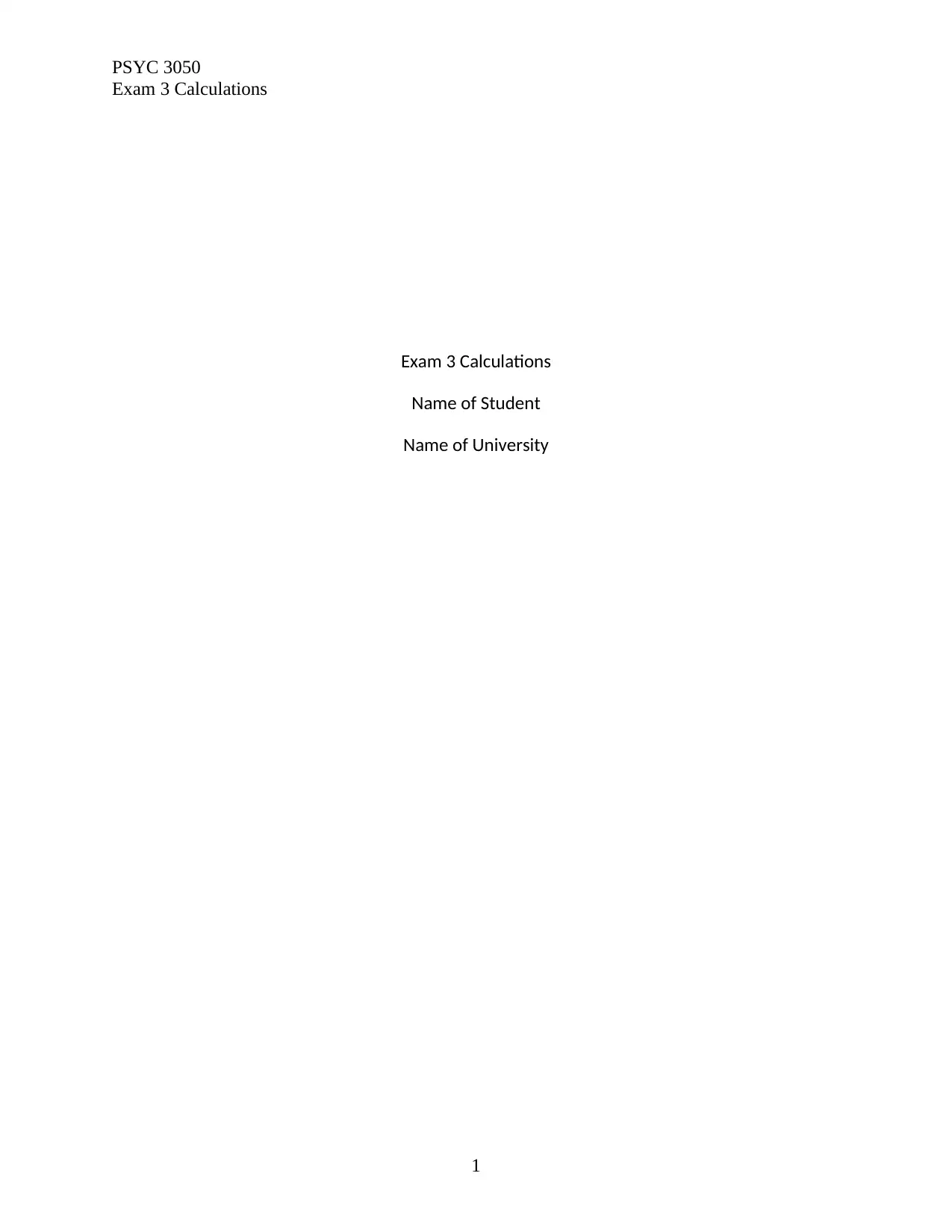
PSYC 3050
Exam 3 Calculations
Exam 3 Calculations
Name of Student
Name of University
1
Exam 3 Calculations
Exam 3 Calculations
Name of Student
Name of University
1
Secure Best Marks with AI Grader
Need help grading? Try our AI Grader for instant feedback on your assignments.
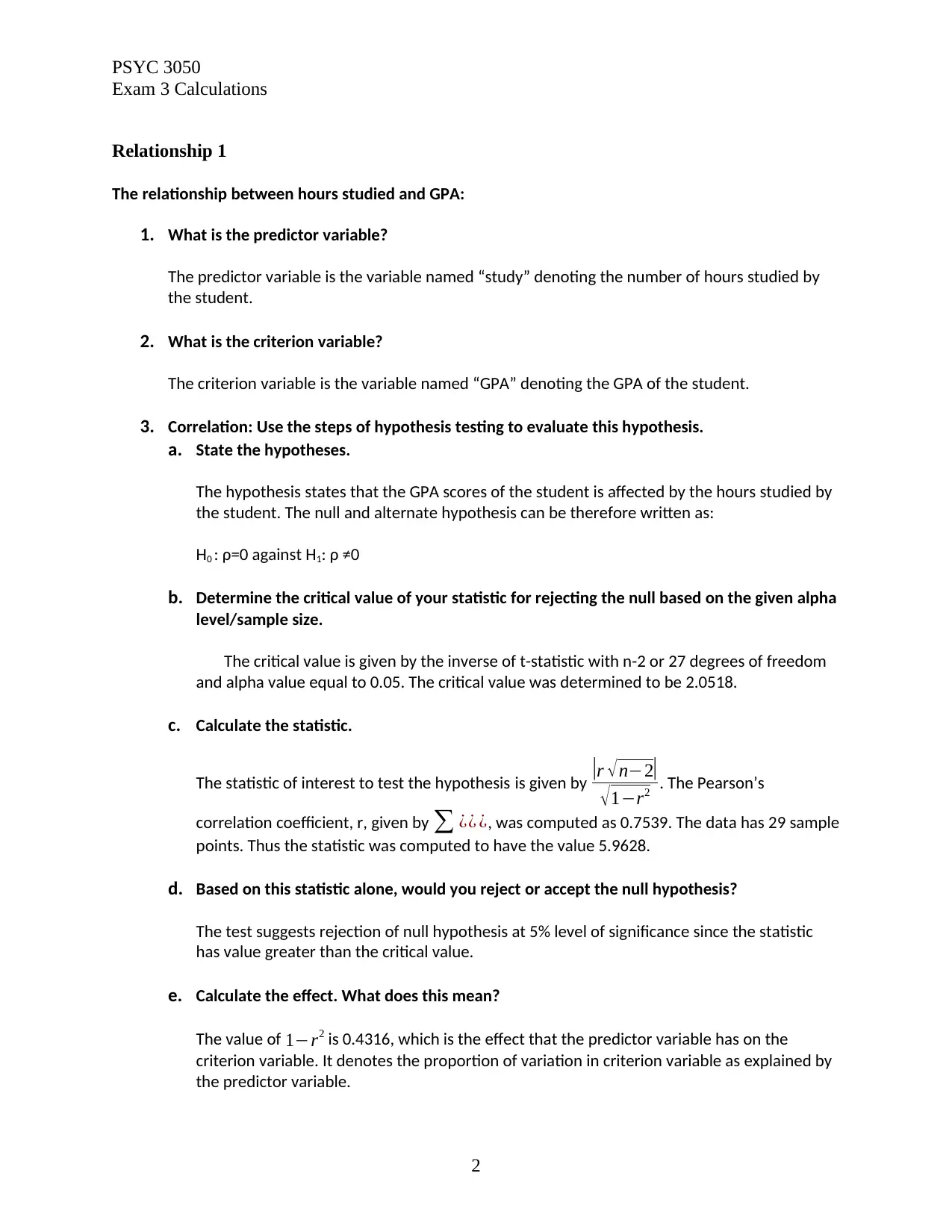
PSYC 3050
Exam 3 Calculations
Relationship 1
The relationship between hours studied and GPA:
1. What is the predictor variable?
The predictor variable is the variable named “study” denoting the number of hours studied by
the student.
2. What is the criterion variable?
The criterion variable is the variable named “GPA” denoting the GPA of the student.
3. Correlation: Use the steps of hypothesis testing to evaluate this hypothesis.
a. State the hypotheses.
The hypothesis states that the GPA scores of the student is affected by the hours studied by
the student. The null and alternate hypothesis can be therefore written as:
H0 : ρ=0 against H1: ρ ≠0
b. Determine the critical value of your statistic for rejecting the null based on the given alpha
level/sample size.
The critical value is given by the inverse of t-statistic with n-2 or 27 degrees of freedom
and alpha value equal to 0.05. The critical value was determined to be 2.0518.
c. Calculate the statistic.
The statistic of interest to test the hypothesis is given by |r √n−2|
√1−r2 . The Pearson’s
correlation coefficient, r, given by ∑ ¿¿ ¿, was computed as 0.7539. The data has 29 sample
points. Thus the statistic was computed to have the value 5.9628.
d. Based on this statistic alone, would you reject or accept the null hypothesis?
The test suggests rejection of null hypothesis at 5% level of significance since the statistic
has value greater than the critical value.
e. Calculate the effect. What does this mean?
The value of 1−r2 is 0.4316, which is the effect that the predictor variable has on the
criterion variable. It denotes the proportion of variation in criterion variable as explained by
the predictor variable.
2
Exam 3 Calculations
Relationship 1
The relationship between hours studied and GPA:
1. What is the predictor variable?
The predictor variable is the variable named “study” denoting the number of hours studied by
the student.
2. What is the criterion variable?
The criterion variable is the variable named “GPA” denoting the GPA of the student.
3. Correlation: Use the steps of hypothesis testing to evaluate this hypothesis.
a. State the hypotheses.
The hypothesis states that the GPA scores of the student is affected by the hours studied by
the student. The null and alternate hypothesis can be therefore written as:
H0 : ρ=0 against H1: ρ ≠0
b. Determine the critical value of your statistic for rejecting the null based on the given alpha
level/sample size.
The critical value is given by the inverse of t-statistic with n-2 or 27 degrees of freedom
and alpha value equal to 0.05. The critical value was determined to be 2.0518.
c. Calculate the statistic.
The statistic of interest to test the hypothesis is given by |r √n−2|
√1−r2 . The Pearson’s
correlation coefficient, r, given by ∑ ¿¿ ¿, was computed as 0.7539. The data has 29 sample
points. Thus the statistic was computed to have the value 5.9628.
d. Based on this statistic alone, would you reject or accept the null hypothesis?
The test suggests rejection of null hypothesis at 5% level of significance since the statistic
has value greater than the critical value.
e. Calculate the effect. What does this mean?
The value of 1−r2 is 0.4316, which is the effect that the predictor variable has on the
criterion variable. It denotes the proportion of variation in criterion variable as explained by
the predictor variable.
2
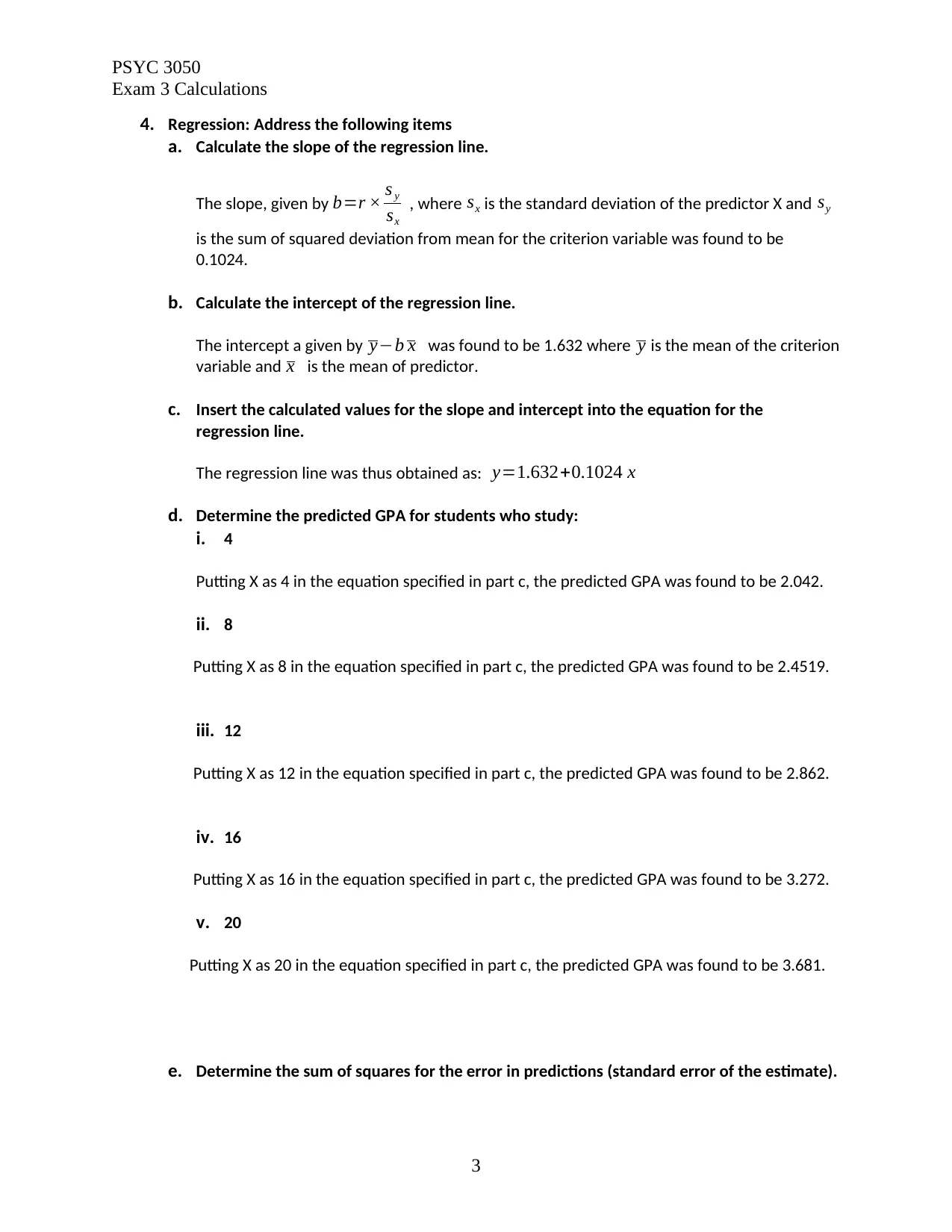
PSYC 3050
Exam 3 Calculations
4. Regression: Address the following items
a. Calculate the slope of the regression line.
The slope, given by b=r × s y
sx
, where sx is the standard deviation of the predictor X and sy
is the sum of squared deviation from mean for the criterion variable was found to be
0.1024.
b. Calculate the intercept of the regression line.
The intercept a given by y−b x was found to be 1.632 where y is the mean of the criterion
variable and x is the mean of predictor.
c. Insert the calculated values for the slope and intercept into the equation for the
regression line.
The regression line was thus obtained as: y=1.632+0.1024 x
d. Determine the predicted GPA for students who study:
i. 4
Putting X as 4 in the equation specified in part c, the predicted GPA was found to be 2.042.
ii. 8
Putting X as 8 in the equation specified in part c, the predicted GPA was found to be 2.4519.
iii. 12
Putting X as 12 in the equation specified in part c, the predicted GPA was found to be 2.862.
iv. 16
Putting X as 16 in the equation specified in part c, the predicted GPA was found to be 3.272.
v. 20
Putting X as 20 in the equation specified in part c, the predicted GPA was found to be 3.681.
e. Determine the sum of squares for the error in predictions (standard error of the estimate).
3
Exam 3 Calculations
4. Regression: Address the following items
a. Calculate the slope of the regression line.
The slope, given by b=r × s y
sx
, where sx is the standard deviation of the predictor X and sy
is the sum of squared deviation from mean for the criterion variable was found to be
0.1024.
b. Calculate the intercept of the regression line.
The intercept a given by y−b x was found to be 1.632 where y is the mean of the criterion
variable and x is the mean of predictor.
c. Insert the calculated values for the slope and intercept into the equation for the
regression line.
The regression line was thus obtained as: y=1.632+0.1024 x
d. Determine the predicted GPA for students who study:
i. 4
Putting X as 4 in the equation specified in part c, the predicted GPA was found to be 2.042.
ii. 8
Putting X as 8 in the equation specified in part c, the predicted GPA was found to be 2.4519.
iii. 12
Putting X as 12 in the equation specified in part c, the predicted GPA was found to be 2.862.
iv. 16
Putting X as 16 in the equation specified in part c, the predicted GPA was found to be 3.272.
v. 20
Putting X as 20 in the equation specified in part c, the predicted GPA was found to be 3.681.
e. Determine the sum of squares for the error in predictions (standard error of the estimate).
3
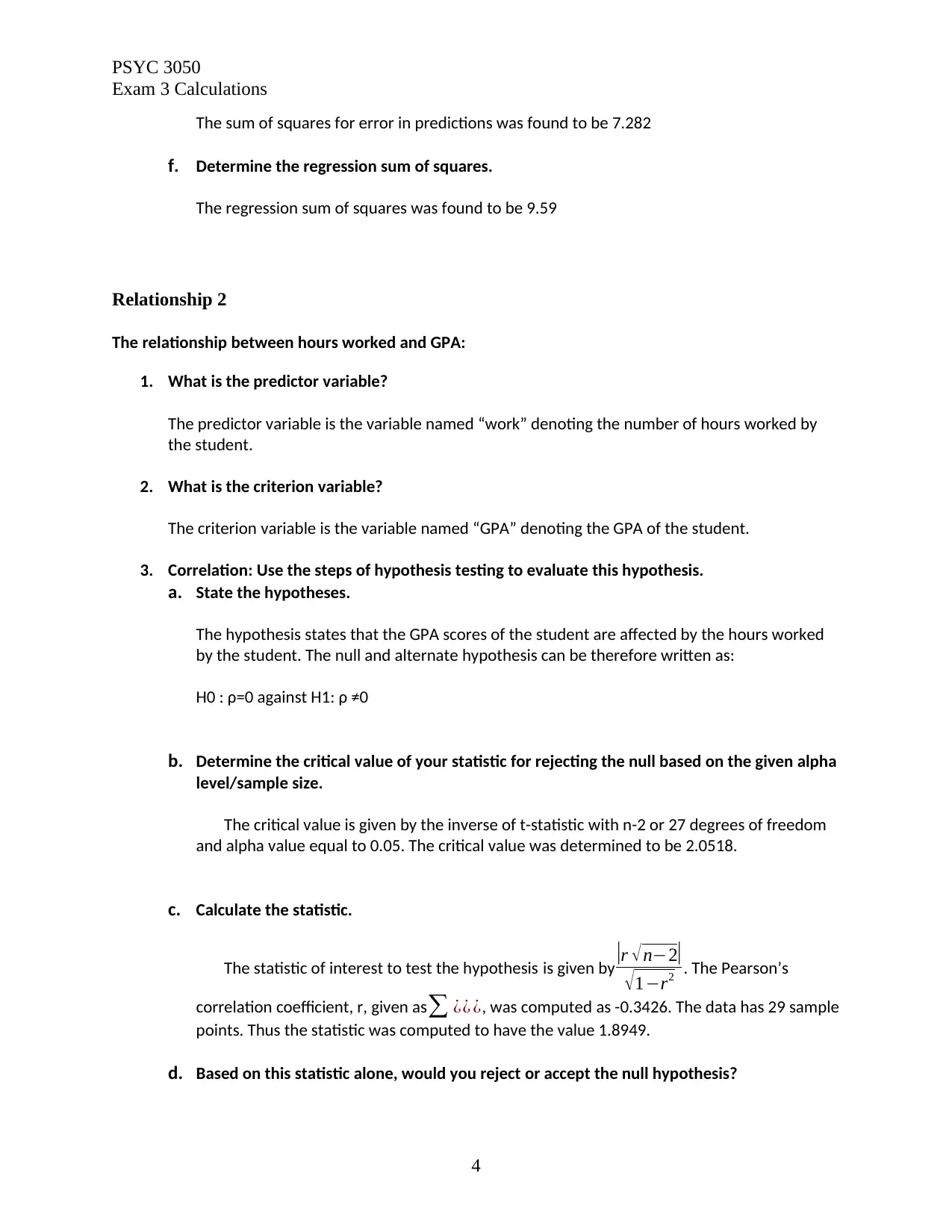
PSYC 3050
Exam 3 Calculations
The sum of squares for error in predictions was found to be 7.282
f. Determine the regression sum of squares.
The regression sum of squares was found to be 9.59
Relationship 2
The relationship between hours worked and GPA:
1. What is the predictor variable?
The predictor variable is the variable named “work” denoting the number of hours worked by
the student.
2. What is the criterion variable?
The criterion variable is the variable named “GPA” denoting the GPA of the student.
3. Correlation: Use the steps of hypothesis testing to evaluate this hypothesis.
a. State the hypotheses.
The hypothesis states that the GPA scores of the student are affected by the hours worked
by the student. The null and alternate hypothesis can be therefore written as:
H0 : ρ=0 against H1: ρ ≠0
b. Determine the critical value of your statistic for rejecting the null based on the given alpha
level/sample size.
The critical value is given by the inverse of t-statistic with n-2 or 27 degrees of freedom
and alpha value equal to 0.05. The critical value was determined to be 2.0518.
c. Calculate the statistic.
The statistic of interest to test the hypothesis is given by |r √ n−2|
√ 1−r2 . The Pearson’s
correlation coefficient, r, given as∑ ¿¿ ¿, was computed as -0.3426. The data has 29 sample
points. Thus the statistic was computed to have the value 1.8949.
d. Based on this statistic alone, would you reject or accept the null hypothesis?
4
Exam 3 Calculations
The sum of squares for error in predictions was found to be 7.282
f. Determine the regression sum of squares.
The regression sum of squares was found to be 9.59
Relationship 2
The relationship between hours worked and GPA:
1. What is the predictor variable?
The predictor variable is the variable named “work” denoting the number of hours worked by
the student.
2. What is the criterion variable?
The criterion variable is the variable named “GPA” denoting the GPA of the student.
3. Correlation: Use the steps of hypothesis testing to evaluate this hypothesis.
a. State the hypotheses.
The hypothesis states that the GPA scores of the student are affected by the hours worked
by the student. The null and alternate hypothesis can be therefore written as:
H0 : ρ=0 against H1: ρ ≠0
b. Determine the critical value of your statistic for rejecting the null based on the given alpha
level/sample size.
The critical value is given by the inverse of t-statistic with n-2 or 27 degrees of freedom
and alpha value equal to 0.05. The critical value was determined to be 2.0518.
c. Calculate the statistic.
The statistic of interest to test the hypothesis is given by |r √ n−2|
√ 1−r2 . The Pearson’s
correlation coefficient, r, given as∑ ¿¿ ¿, was computed as -0.3426. The data has 29 sample
points. Thus the statistic was computed to have the value 1.8949.
d. Based on this statistic alone, would you reject or accept the null hypothesis?
4
Secure Best Marks with AI Grader
Need help grading? Try our AI Grader for instant feedback on your assignments.
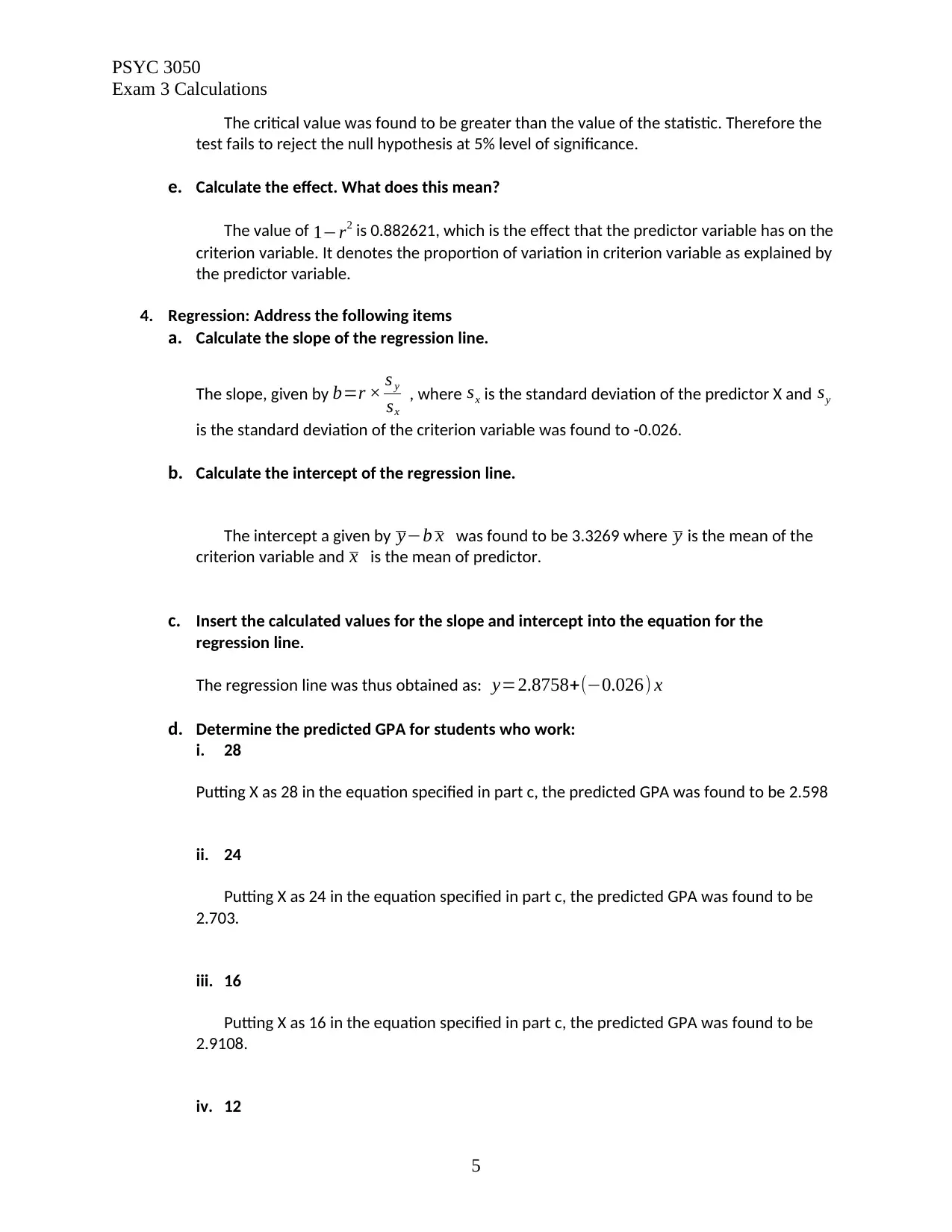
PSYC 3050
Exam 3 Calculations
The critical value was found to be greater than the value of the statistic. Therefore the
test fails to reject the null hypothesis at 5% level of significance.
e. Calculate the effect. What does this mean?
The value of 1−r2 is 0.882621, which is the effect that the predictor variable has on the
criterion variable. It denotes the proportion of variation in criterion variable as explained by
the predictor variable.
4. Regression: Address the following items
a. Calculate the slope of the regression line.
The slope, given by b=r × s y
sx
, where sx is the standard deviation of the predictor X and sy
is the standard deviation of the criterion variable was found to -0.026.
b. Calculate the intercept of the regression line.
The intercept a given by y−b x was found to be 3.3269 where y is the mean of the
criterion variable and x is the mean of predictor.
c. Insert the calculated values for the slope and intercept into the equation for the
regression line.
The regression line was thus obtained as: y=2.8758+(−0.026) x
d. Determine the predicted GPA for students who work:
i. 28
Putting X as 28 in the equation specified in part c, the predicted GPA was found to be 2.598
ii. 24
Putting X as 24 in the equation specified in part c, the predicted GPA was found to be
2.703.
iii. 16
Putting X as 16 in the equation specified in part c, the predicted GPA was found to be
2.9108.
iv. 12
5
Exam 3 Calculations
The critical value was found to be greater than the value of the statistic. Therefore the
test fails to reject the null hypothesis at 5% level of significance.
e. Calculate the effect. What does this mean?
The value of 1−r2 is 0.882621, which is the effect that the predictor variable has on the
criterion variable. It denotes the proportion of variation in criterion variable as explained by
the predictor variable.
4. Regression: Address the following items
a. Calculate the slope of the regression line.
The slope, given by b=r × s y
sx
, where sx is the standard deviation of the predictor X and sy
is the standard deviation of the criterion variable was found to -0.026.
b. Calculate the intercept of the regression line.
The intercept a given by y−b x was found to be 3.3269 where y is the mean of the
criterion variable and x is the mean of predictor.
c. Insert the calculated values for the slope and intercept into the equation for the
regression line.
The regression line was thus obtained as: y=2.8758+(−0.026) x
d. Determine the predicted GPA for students who work:
i. 28
Putting X as 28 in the equation specified in part c, the predicted GPA was found to be 2.598
ii. 24
Putting X as 24 in the equation specified in part c, the predicted GPA was found to be
2.703.
iii. 16
Putting X as 16 in the equation specified in part c, the predicted GPA was found to be
2.9108.
iv. 12
5
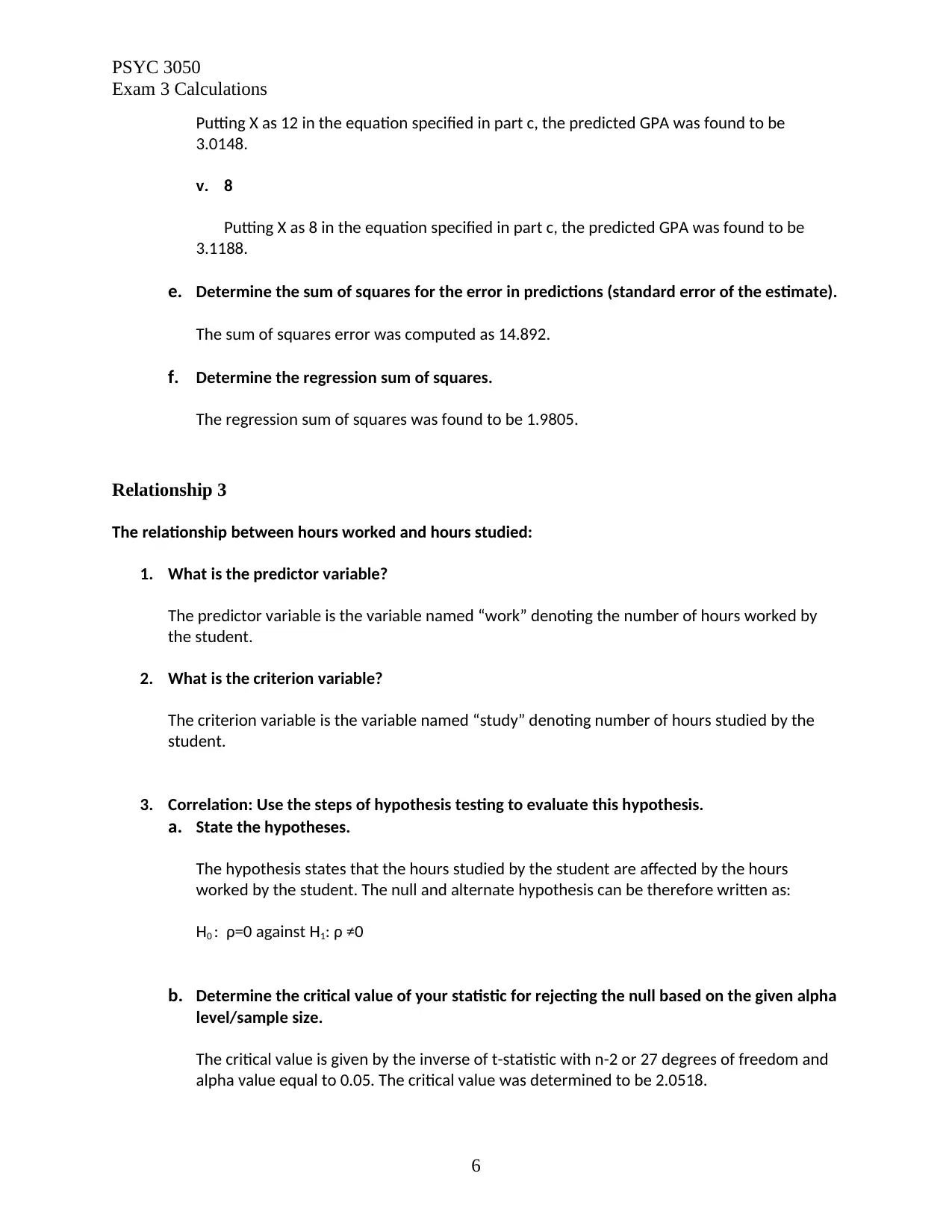
PSYC 3050
Exam 3 Calculations
Putting X as 12 in the equation specified in part c, the predicted GPA was found to be
3.0148.
v. 8
Putting X as 8 in the equation specified in part c, the predicted GPA was found to be
3.1188.
e. Determine the sum of squares for the error in predictions (standard error of the estimate).
The sum of squares error was computed as 14.892.
f. Determine the regression sum of squares.
The regression sum of squares was found to be 1.9805.
Relationship 3
The relationship between hours worked and hours studied:
1. What is the predictor variable?
The predictor variable is the variable named “work” denoting the number of hours worked by
the student.
2. What is the criterion variable?
The criterion variable is the variable named “study” denoting number of hours studied by the
student.
3. Correlation: Use the steps of hypothesis testing to evaluate this hypothesis.
a. State the hypotheses.
The hypothesis states that the hours studied by the student are affected by the hours
worked by the student. The null and alternate hypothesis can be therefore written as:
H0 : ρ=0 against H1: ρ ≠0
b. Determine the critical value of your statistic for rejecting the null based on the given alpha
level/sample size.
The critical value is given by the inverse of t-statistic with n-2 or 27 degrees of freedom and
alpha value equal to 0.05. The critical value was determined to be 2.0518.
6
Exam 3 Calculations
Putting X as 12 in the equation specified in part c, the predicted GPA was found to be
3.0148.
v. 8
Putting X as 8 in the equation specified in part c, the predicted GPA was found to be
3.1188.
e. Determine the sum of squares for the error in predictions (standard error of the estimate).
The sum of squares error was computed as 14.892.
f. Determine the regression sum of squares.
The regression sum of squares was found to be 1.9805.
Relationship 3
The relationship between hours worked and hours studied:
1. What is the predictor variable?
The predictor variable is the variable named “work” denoting the number of hours worked by
the student.
2. What is the criterion variable?
The criterion variable is the variable named “study” denoting number of hours studied by the
student.
3. Correlation: Use the steps of hypothesis testing to evaluate this hypothesis.
a. State the hypotheses.
The hypothesis states that the hours studied by the student are affected by the hours
worked by the student. The null and alternate hypothesis can be therefore written as:
H0 : ρ=0 against H1: ρ ≠0
b. Determine the critical value of your statistic for rejecting the null based on the given alpha
level/sample size.
The critical value is given by the inverse of t-statistic with n-2 or 27 degrees of freedom and
alpha value equal to 0.05. The critical value was determined to be 2.0518.
6

PSYC 3050
Exam 3 Calculations
c. Calculate the statistic.
The statistic of interest to test the hypothesis is given by |r √n−2|
√1−r2 . The Pearson’s
correlation coefficient, r, given by ∑ ¿¿ ¿, was computed as –0.235. The data has 29
sample points. Thus the statistic was computed to have the value 1.2563.
d. Based on this statistic alone, would you reject or accept the null hypothesis?
The critical value was found to be greater than the value of the statistic. Therefore the test
fails to reject the null hypothesis at 5% level of significance. The null is therefore accepted.
e. Calculate the effect. What does this mean?
The value of 1−r2 is 0.94476, which is the effect that the predictor variable has on the
criterion variable. It denotes the proportion of variation in criterion variable as explained by
the predictor variable.
Relationship 4
The relationship between hours worked and hours studied for students with high conscientiousness:
1. What is the predictor variable?
The predictor variable is the variable named “study” denoting the number of hours studied by
the students whose conscientiousness was reportedly high.
2. What is the criterion variable?
The criterion variable is the variable named “work” denoting the number of hours studied by the
students whose conscientiousness was reportedly high.
3. Correlation:
a. Calculate the statistic.
The Pearson’s correlation coefficient, r, given by ∑ ¿¿ ¿ was found to be 0.1739.
b. Calculate the effect. What does this mean?
The value of 1−r2 is 0.94476, which is the effect that the predictor variable has on the
criterion variable. It denotes the proportion of variation in criterion variable as explained by
the predictor variable.
7
Exam 3 Calculations
c. Calculate the statistic.
The statistic of interest to test the hypothesis is given by |r √n−2|
√1−r2 . The Pearson’s
correlation coefficient, r, given by ∑ ¿¿ ¿, was computed as –0.235. The data has 29
sample points. Thus the statistic was computed to have the value 1.2563.
d. Based on this statistic alone, would you reject or accept the null hypothesis?
The critical value was found to be greater than the value of the statistic. Therefore the test
fails to reject the null hypothesis at 5% level of significance. The null is therefore accepted.
e. Calculate the effect. What does this mean?
The value of 1−r2 is 0.94476, which is the effect that the predictor variable has on the
criterion variable. It denotes the proportion of variation in criterion variable as explained by
the predictor variable.
Relationship 4
The relationship between hours worked and hours studied for students with high conscientiousness:
1. What is the predictor variable?
The predictor variable is the variable named “study” denoting the number of hours studied by
the students whose conscientiousness was reportedly high.
2. What is the criterion variable?
The criterion variable is the variable named “work” denoting the number of hours studied by the
students whose conscientiousness was reportedly high.
3. Correlation:
a. Calculate the statistic.
The Pearson’s correlation coefficient, r, given by ∑ ¿¿ ¿ was found to be 0.1739.
b. Calculate the effect. What does this mean?
The value of 1−r2 is 0.94476, which is the effect that the predictor variable has on the
criterion variable. It denotes the proportion of variation in criterion variable as explained by
the predictor variable.
7
Paraphrase This Document
Need a fresh take? Get an instant paraphrase of this document with our AI Paraphraser
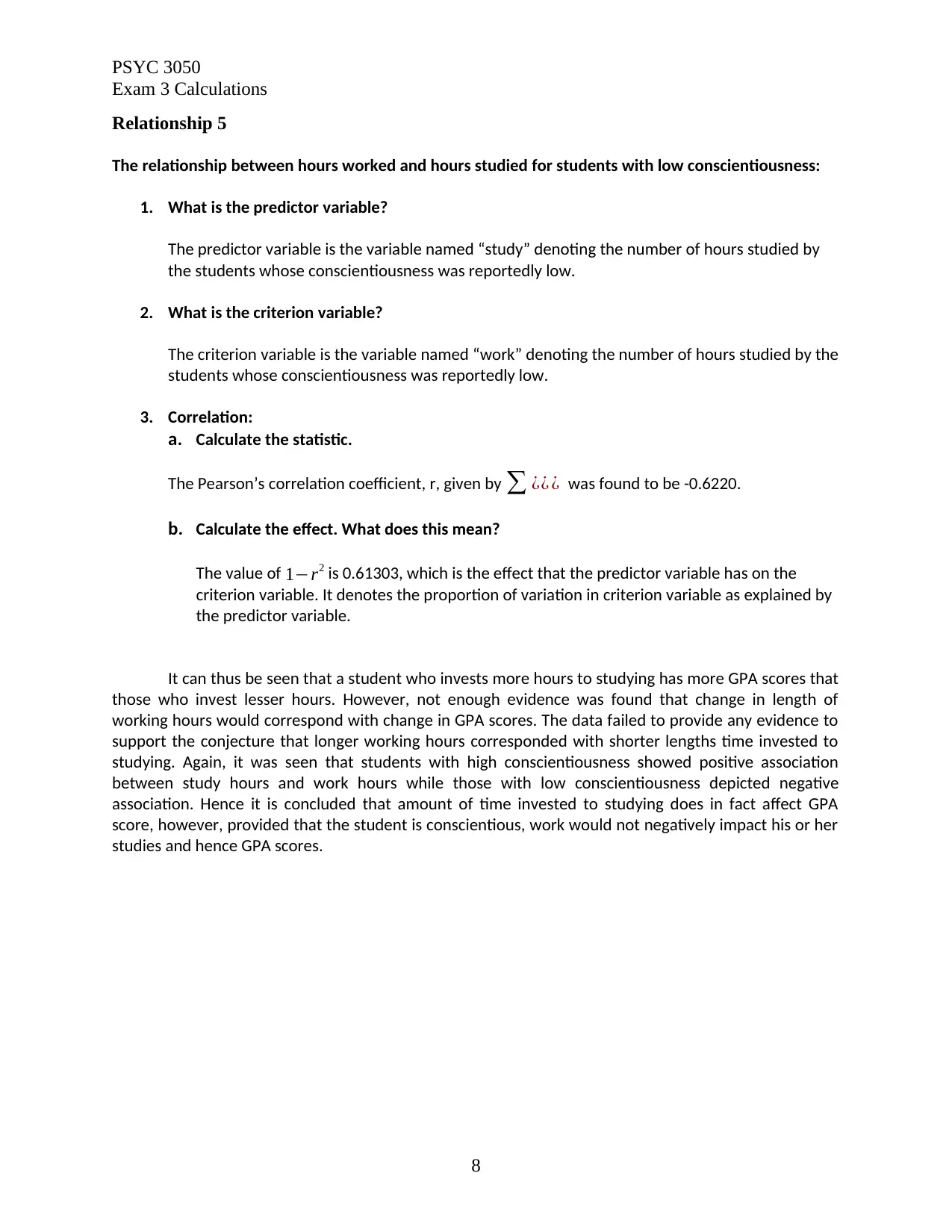
PSYC 3050
Exam 3 Calculations
Relationship 5
The relationship between hours worked and hours studied for students with low conscientiousness:
1. What is the predictor variable?
The predictor variable is the variable named “study” denoting the number of hours studied by
the students whose conscientiousness was reportedly low.
2. What is the criterion variable?
The criterion variable is the variable named “work” denoting the number of hours studied by the
students whose conscientiousness was reportedly low.
3. Correlation:
a. Calculate the statistic.
The Pearson’s correlation coefficient, r, given by ∑ ¿¿ ¿ was found to be -0.6220.
b. Calculate the effect. What does this mean?
The value of 1−r2 is 0.61303, which is the effect that the predictor variable has on the
criterion variable. It denotes the proportion of variation in criterion variable as explained by
the predictor variable.
It can thus be seen that a student who invests more hours to studying has more GPA scores that
those who invest lesser hours. However, not enough evidence was found that change in length of
working hours would correspond with change in GPA scores. The data failed to provide any evidence to
support the conjecture that longer working hours corresponded with shorter lengths time invested to
studying. Again, it was seen that students with high conscientiousness showed positive association
between study hours and work hours while those with low conscientiousness depicted negative
association. Hence it is concluded that amount of time invested to studying does in fact affect GPA
score, however, provided that the student is conscientious, work would not negatively impact his or her
studies and hence GPA scores.
8
Exam 3 Calculations
Relationship 5
The relationship between hours worked and hours studied for students with low conscientiousness:
1. What is the predictor variable?
The predictor variable is the variable named “study” denoting the number of hours studied by
the students whose conscientiousness was reportedly low.
2. What is the criterion variable?
The criterion variable is the variable named “work” denoting the number of hours studied by the
students whose conscientiousness was reportedly low.
3. Correlation:
a. Calculate the statistic.
The Pearson’s correlation coefficient, r, given by ∑ ¿¿ ¿ was found to be -0.6220.
b. Calculate the effect. What does this mean?
The value of 1−r2 is 0.61303, which is the effect that the predictor variable has on the
criterion variable. It denotes the proportion of variation in criterion variable as explained by
the predictor variable.
It can thus be seen that a student who invests more hours to studying has more GPA scores that
those who invest lesser hours. However, not enough evidence was found that change in length of
working hours would correspond with change in GPA scores. The data failed to provide any evidence to
support the conjecture that longer working hours corresponded with shorter lengths time invested to
studying. Again, it was seen that students with high conscientiousness showed positive association
between study hours and work hours while those with low conscientiousness depicted negative
association. Hence it is concluded that amount of time invested to studying does in fact affect GPA
score, however, provided that the student is conscientious, work would not negatively impact his or her
studies and hence GPA scores.
8
1 out of 8
Related Documents
Your All-in-One AI-Powered Toolkit for Academic Success.
+13062052269
info@desklib.com
Available 24*7 on WhatsApp / Email
![[object Object]](/_next/static/media/star-bottom.7253800d.svg)
Unlock your academic potential
© 2024 | Zucol Services PVT LTD | All rights reserved.





